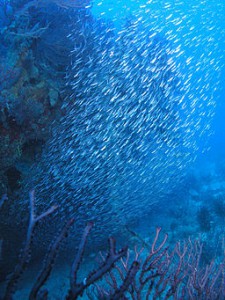 Marine ecosystems worldwide are suffering from a loss of biodiversity due to destruction of food chains and habitats. In particular, the effects of commercial fishing on sensitive ecosystems and species has had disastrous effects on marine life in recent years. One way to mitigate for these effects is to create areas which are set aside to protect vulnerable environments and species, or to provide a safe pocket from which fish and larvae can re-seed away from over-exploited seas. These areas are called Marine Protected Areas (MPAs), and play a significant part in global marine conservation strategies, although their effectiveness if often disputed.
Marine ecosystems worldwide are suffering from a loss of biodiversity due to destruction of food chains and habitats. In particular, the effects of commercial fishing on sensitive ecosystems and species has had disastrous effects on marine life in recent years. One way to mitigate for these effects is to create areas which are set aside to protect vulnerable environments and species, or to provide a safe pocket from which fish and larvae can re-seed away from over-exploited seas. These areas are called Marine Protected Areas (MPAs), and play a significant part in global marine conservation strategies, although their effectiveness if often disputed.
MPAs have been shown to be effective in increasing density and biomass of fish, as well as invertebrates such as lobster and scallops, finds a new systematic review published today in Environmental Evidence. A number of variables affecting how well MPAs protected species and ecosystems were identified by this meta-analysis. The findings suggest that the size of the area and the degree of protection may influence the effectiveness of the MPA, although even partial protection can confer significant ecological benefits.

The UK based team found that MPAs increased fish density and that even partial protection increased fish biomass by almost 50%, while fully protected ‘no take’ areas had double the biomass. This effect was most noticeable for target species, showing that these areas are effective in protecting the species of highest conservation or economic concern. In particular lobsters and scallops showed a positive response to partial protection. None of the styles of protection increased the number of fish species, therefore other methods may be required to encourage increased biodiversity in these areas.
Overall marine protection is a success story however the success of a reserve also depended on its size and how it was managed. Marija Sciberras, from Bangor University, explained, “Even within partial protection reserves there was variation – the ones which allowed recreational fishing had more biomass than open areas, whereas the ones that were previously commercially dredged showed no real improvement relative to open (or fished) areas. Interestingly we found that increasing the size of partial protection areas above 1000km2 reduced their effectiveness. While this is worrying, we suspect that it may be due to increased poaching.”
Latest posts by Rhiannon Meaden (see all)
- Guinea pig teenagers are highly domesticated - 9th April 2014
- Goats, the boffins of the farmyard - 26th March 2014
- Developments in Daphnia - 25th March 2014
Comments